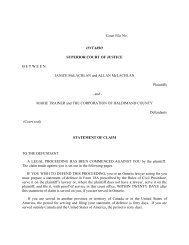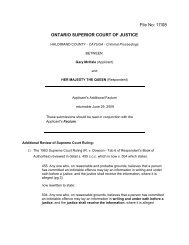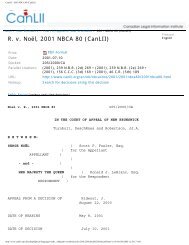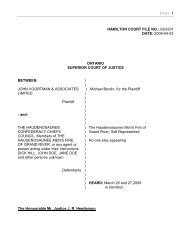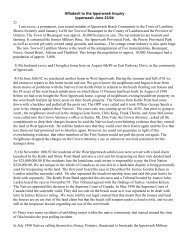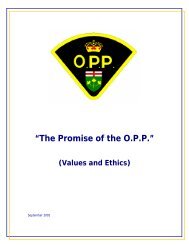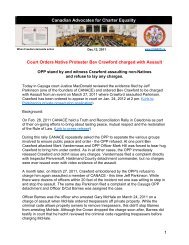Other People's Wars - Caledonia Wake Up Call
Other People's Wars - Caledonia Wake Up Call
Other People's Wars - Caledonia Wake Up Call
You also want an ePaper? Increase the reach of your titles
YUMPU automatically turns print PDFs into web optimized ePapers that Google loves.
<strong>Other</strong> Peoples’ <strong>Wars</strong> -- Chapter TwoThe man chosen to fulfill this role was the now infamous Jarnail Singh Bhindranwale, then amoderately popular and charismatic religious leader. Behind the scenes, Congress Partyhandlers helped promote a new Punjab-based Sikh party, the Dal Khalsa (“party of the pure)for him. Even at this early stage, Bhindranwale was known to be both prone to religiousviolence, and a strong advocate of an independent Sikh state. 10In a remarkably short period of time, Bhindranwale was able to manipulate the teachings ofSikhism’s original gurus, and create for himself an armed and dedicated following using the DalKhalsa (DK). By 1981, he had already been implicated in murdering two gurus of theNirankari sect of Sikhism (whom many Sikhs view as “heretics”). In 1978, he led a violentconfrontation at one of their events, in which three Nirankaris and twelve DK members werekilled. By this point it was readily apparent that the Congress Party had lost control of theirpawn.Bhindranwale established training camps at various temples and recruited more followers.One of the most important strategic alliances he forged was with the All-India Sikh Student’sFederation. It also had a history of separatist-inspired violence in the Punjab, including robberyand murder.In 1983, India’s military intelligence, the Research and Analysis Wing (RAW) unsuccessfullytried to infiltrate Bhindranwale’s organization, and over 100 intelligence officers died in theseattempts. 11 Later that year, the killing of police officials escalated to the point where the centralgovernment stepped in and took control of the Punjab. The state’s policing operatio ns wereseverely hampered by the massive network developed by Bhindranwale’s followers that couldeasily target any individual or police officer who acted against them. Through a combination ofboth intimidation and the rallying of pro-Sikh emotions, Bhindranwale moved into the GoldenTemple, the religion’s holiest site, heavily fortified it, and made it his base of operations.Security forces surrounded the Golden Temple, claiming a fear that Bhindranwale woulddeclare an independent Khalistan (the name of the Sikh state they wanted to create) andconcerns that India’s arch-rival Pakistan might be helping to foment ethnic unrest. Bhindranwalerefused to surrender, and by June 6, 1984, security forces assaulted the temple in what wasthen called Operation Blue Star. Bhindranwale was killed in the engagement.The political and emotional fall-out caused by the action was far-reaching within the Sikhcommunities in India and abroad. Many were disgusted that the final assault occurred on thedate Sikhs celebrate the martyrdom of Guru Arjun. Hundreds of innocent pilgrims were at thetemple at the time celebrating the event. While official death tolls were not believed, the numberkilled is estimated to be in the low thousands.The assault on the Golden Temple offered radicals an instant legitimacy within a wider segmentof the Punjab’s population; more than they could have ever attained had it not occurred. Ethnictensions were further inflamed when, on October 31, 1984, two of Indira Gandhi’s Sikh10 Yaeger, Carl “Sikh Terrorism in the Struggle for Khalistan” in Terrorism an International Journal Vol. 14,No. 4 Oct. -Dec. 1991 p. 223.11 Yeager, 1991.36



